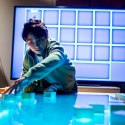‘Hacking’ to bridge a divide
On a wall in a darkened room, a single word flashed: divide.
David Krakauer, director of the Wisconsin Institute for Discovery (WID), explained to a roomful of humanities scholars that for too long, the disciplines of math and science have been growing apart from the study of art, music, philosophy and literature.
“It’s a loss on both sides,” he says. “That’s why we’re here.”
“Here” was a teaching lab in the Wisconsin Institutes for Discovery building, where Krakauer helped introduce the Humanities Hackathon, a weeklong course in late July designed to bring math and science experts together with humanists.
The goal: to explore emerging computational techniques for analyzing works of art, literature and music. With millions of texts (and other works) online, it is now possible for humanists to study “cultural quantities” using some of the same data-processing techniques that scientists use to study genomes, for example, or cells.
“We encourage radical cross-fertilization of ideas,” says Sara Guyer, director of the Center for the Humanities, which collaborated with WID on the short summer course. “By bridging the two cultures of science and the humanities, scholars can engage more fully around the question: What is human?”
Video — Humanities Hackathon:
Expanding Campus Perspectives
The course name reflects a Silicon Valley sensibility, where “hackathons” first began as collaborative sessions designed to work the kinks out of new software. For many designers, engineers and scholars, “hacking” now means exploring the possibilities of tools or ideas in new and creative ways. Drawing together grad students, professors, center directors and campus librarians, the Humanities Hackathon offered a chance to experiment with data-mining software to create 3-D graphs, network maps and other large-scale visualizations. Instead of numbers, participants plugged in characters, relationships and words.
For example, Jillian Sayre, a lecturer in English who teaches an advanced undergraduate course on “Moby Dick,” wanted to map the network of author Herman Melville’s whaling ship, Pequod. But she soon learned about the challenges of exploring a work of literature through a quantitative lens.
“Do I include the ships that Pequod met on the way? Their crews, their owners? Whether the ships were setting out or returning to port?” Sayre asks. “These aren’t numbers — their significance must be weighed.”
For Sayre, that moment revealed the Humanities Hackathon as a zone of uncertainty, discomfort and doubt — all of which, she says, is beneficial to scholarship.
“Only when you don’t know where you are can you find new and different ways to climb out,” she says.
Though the short course was the first of its kind on campus, UW–Madison has been experimenting with computational methods for humanities research since 2004, when Michael Witmore, a former English professor (now head of the Folger Shakespeare Library) began data mining Shakespeare’s plays. Witmore unearthed linguistic patterns that proved “Othello,” once read purely as a tragedy, contained many comedic elements. Since then, experts in methodological approaches to the humanities have emerged in several departments, including art, history, English and digital studies.
For most humanities scholars, though, computation is still uncharted territory. Quantitative methods aren’t widely embraced in the classroom, where “close reading” — lingering with the smallest details of a text or other work — is still the norm.
As Hackathon instructors delved into matrices, vectors and lists, a few course participants shifted in their seats. One person asked for an example “that a humanist could understand.” That’s all part of the fun, according to Guyer, who says hackathons, by nature, are supposed to explode traditional thinking and even be “a bit subversive.”
“One of the exciting parts of this was the reversal of how the humanities and the sciences usually interact,” she says. “Usually, scientists have an object — stem cells, say — and we bring methods (ethics, rhetorical analysis). But in this collaboration, humanities scholars bring the objects: texts, maps, history. And science provides the method.”
Yet questions remain: Is it possible for a computer to identify irony, or the complexity of poetic language, for example? Probably not, Guyer says, but she agrees with WID director Krakauer that in the digitized universe we now inhabit, these are exciting tools for a scholar’s analytical portfolio.
“I think these methods work in combination with traditional approaches, opening up a new way of seeing,” she says. “Large-scale visualizations might give us a completely different understanding of a piece of music, a novel or a series of drawings.”
Mark Vareschi, assistant professor of English, agrees. He came to the Hackathon with data transcribed from more than 1,500 playbills from the mid-18th century. Many of the plays have no authorial attribution, and like many scholars who deal with anonymity, Vareschi would like to know why.
“I wanted to graph the entire corpus for trends,” he says. “Do the attributed works cluster in some way?”
Vareschi says the canon of 18th century literature includes about 100 regularly studied texts, but there are thousands more plays and novels from that period that scholars never look at.
“Now, with these techniques, we can,” he says. “It changes the larger story.”
Constructing a new type of bridge on campus, WID will host informal, monthly hackathons where math and science experts, together with humanities scholars, can continue to investigate new tools and methods. The hope, according to Krakauer, is to create “scholars who are comfortable in both worlds.”
—By Mary Ellen Gabriel and Marianne English


